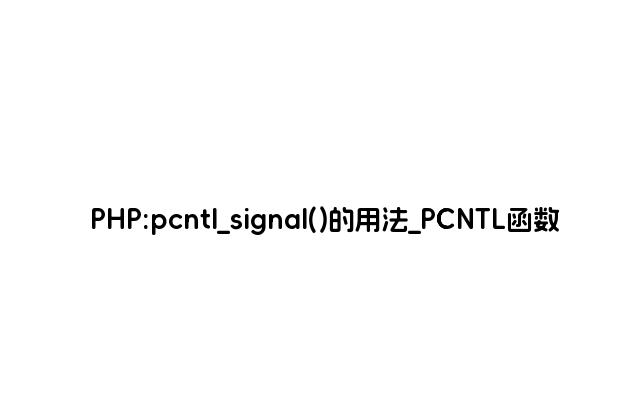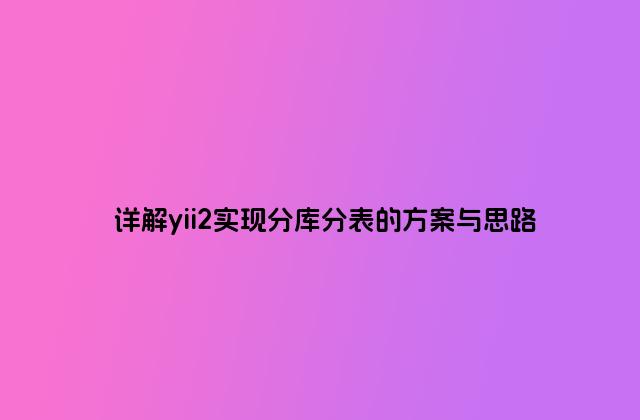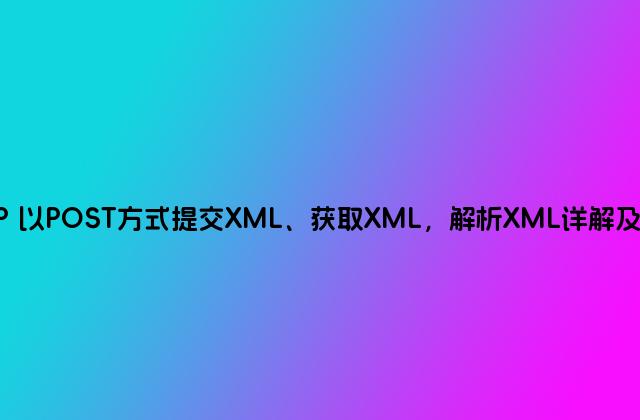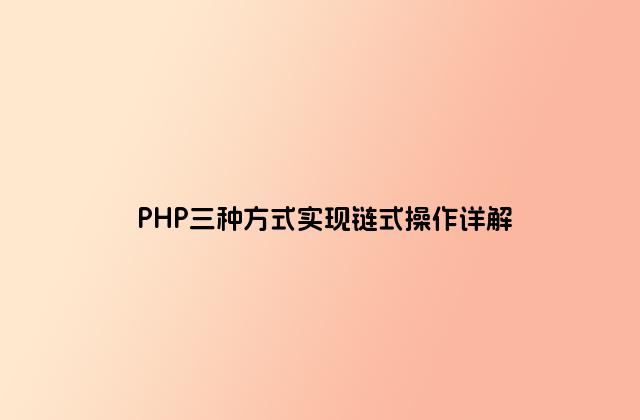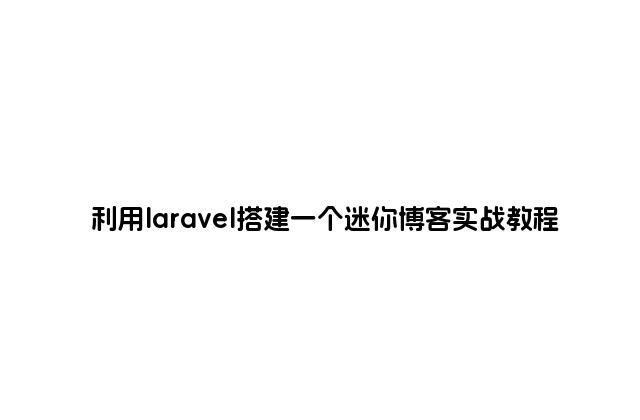
本文主要給大家介紹的是關(guān)于利用laravel搭建一個迷你博客的相關(guān)內(nèi)容,分享出來供大家參考學(xué)習(xí),下面話不多說了,來一起看看詳細的介紹:
一、設(shè)計與思路
在開始寫第一行代碼之前,一定要盡量從頭到尾將我們要做的產(chǎn)品設(shè)計好,避免寫完又改,多寫不必要的代碼。
需求分析:我們的迷你博客應(yīng)該至少包含:新增/編輯/查看/刪除文章,以及文章列表展示功能。 數(shù)據(jù)庫分析:基于這個功能,我們只需要一張 Articles 數(shù)據(jù)表來存放文章即可。 頁面結(jié)構(gòu)分析:應(yīng)該使用模板繼承建立一張基礎(chǔ)模板包含:頭部/文章列表/底部信息二、創(chuàng)建路由
完成這個博客大概需要以下幾條路由:
| 路由 | 功能 | | -------- | ---------------- | | 文章列表頁面路由 | 返回文章列表頁面 | | 新增文章頁面路由 | 返回新增文章頁面 | | 文章保存功能路由 | 將文章保存到數(shù)據(jù)庫 | | 查看文章頁面路由 | 返回文章詳情頁面 | | 編輯文章頁面路由 | 返回編輯文章頁面 | | 編輯文章功能路由 | 將文章取出更新后重新保存到數(shù)據(jù)庫 | | 刪除文章功能路由 | 將文章從數(shù)據(jù)庫刪除 |
可以看到幾乎全部是對文章的數(shù)據(jù)操作路由,針對這種情況,Laravel 提供了非常方便的辦法:RESTful 資源控制器和路由。
打開routes.php加入如下代碼:
Route::resource('articles', 'ArticlesController');
只需要上面這樣一行代碼,就相當(dāng)于創(chuàng)建了如下7條路由,且都是命名路由,我們可以使用類似route('articles.show') 這樣的用法。
Route::get('/articles', 'ArticlesController@index')->name('articles.index');
Route::get('/articles/{id}', 'ArticlesController@show')->name('articles.show');
Route::get('/articles/create', 'ArticlesController@create')->name('articles.create');
Route::post('/articles', 'ArticlesController@store')->name('articles.store');
Route::get('/articles/{id}/edit', 'ArticlesController@edit')->name('articles.edit');
Route::patch('/articles/{id}', 'ArticlesController@update')->name('articles.update');
Route::delete('/articles/{id}', 'ArticlesController@destroy')->name('articles.destroy');
三、創(chuàng)建控制器
利用 artisan 創(chuàng)建一個文章控制器:
php artisan make:controller ArticlesController
四、創(chuàng)建基礎(chǔ)視圖
resources/views/layouts/art.blade.php
見模板index.html
五、新建文章表單
@extends('layouts.art')
@section('content')
<form class="form-horizontal" method="post" action="{{route('blog.store')}}">
{{ csrf_field() }}
<div class="form-group">
<label for="inputEmail3" class="col-sm-2 control-label">標(biāo)題</label>
<div class="col-sm-8">
<input type="title" class="form-control" id="title" name="title">
</div>
</div>
<div class="form-group">
<label for="inputEmail3" class="col-sm-2 control-label">內(nèi)容</label>
<div class="col-sm-8">
<textarea class="form-control" rows="5" id="content" name="content"></textarea>
</div>
</div>
<div class="form-group">
<div class="col-sm-offset-2 col-sm-10">
<button type="submit" class="btn btn-default">創(chuàng)建</button>
</div>
</div>
</form>
@endsection
六、文章存儲
此時如果你填寫新建文章表單點擊提交也會跳到一個空白頁面,同樣的道理,因為我們后續(xù)的控制器代碼還沒寫。
要實現(xiàn)文章存儲,首先要配置數(shù)據(jù)庫,創(chuàng)建數(shù)據(jù)表,創(chuàng)建模型,然后再完成存儲邏輯代碼。
1、配置數(shù)據(jù)庫
修改.env文件
2、創(chuàng)建數(shù)據(jù)表
利用 artisan 命令生成遷移:
php artisan make:migration create_articles_talbe --create=articles
修改遷移文件
public function up()
{
Schema::create('articles', function (Blueprint $table) {
$table->increments('id');
$table->string('title');
$table->longText('content');
$table->timestamps();
});
}
public function down()
{
Schema::dropIfExists('articles');
}
我們創(chuàng)建了一張 articles 表,包含遞增的 id 字段,字符串title字段,長文本content字段,和時間戳。
執(zhí)行數(shù)據(jù)庫遷移:
php artisan migrate
登錄mysql,查看數(shù)據(jù)表。
3、創(chuàng)建模型
利用 artisan 命令創(chuàng)建模型:
php artisan make:model Article
打開模型文件,輸入以下代碼:
app/Article.php
namespace App;
use IlluminateDatabaseEloquentModel;
class Article extends Model
{
//對應(yīng)的表
protected $table = 'articles';
//通過model可以寫入的字段
protected $fillable = [
'title', 'content',
];
}
4、存儲邏輯代碼
打開 ArticlesController.php 控制器,找到 store() 方法。
app/Http/Controllers/ArticlesController.php
public function store(Request $request)
{
//數(shù)據(jù)驗證 錯誤處理
$this->validate($request,[
'title'=>'required|max:50',
'content'=>'required|max:500',
]);
// 1 orm方式寫入
$article = Article::create([
'title'=>$request->title,
'content'=>$request->content,
]);
//2 或者
/* $article = new Article();
$article->title =$request->title;
$article->content = $request->content;
$article->save();*/
//3 db方式寫入
//insert()方法返回值為true 和 false
//$res = DB::table('articles')->insert(['title'=>$request->title,'content'=>$request->content]);
return redirect()->route('blog.index');
}
驗證錯誤顯示
@if (count($errors) > 0)
<div class="alert alert-danger">
<ul>
@foreach($errors->all() as $error)
<li>{{ $error }}</li>
@endforeach
</ul>
</div>
@endif
七、文章列表展示
完成了添加文章功能后,就可以實現(xiàn)我們的文章列表展示頁了。
打開 ArticlesController.php 找到 index() 方法,添加代碼如下:
app/Http/Controllers/ArticlesController.php
use AppArticle;
public function index()
{
$articles = Article::orderBy('created_at','asc')->get();
return view('articles.index', ['articles'=>$articles]);
}
視圖index.blade.php
@extends('layouts.art')
@section('content')
<a class="btn btn-primary" rel="external nofollow" >添加文章</a>
@foreach($articles as $article)
<div class="panel panel-default">
<div class="panel-body">
{{$article->title}}
<a rel="external nofollow" class="btn btn-info">閱讀</a>
<a , $article->id)}}" rel="external nofollow" class="btn btn-info">修改</a>
<form action="{{ route('blog.destroy', $article->id) }}" method="post" style="display: inline-block;">
{{ csrf_field() }}
{{ method_field('DELETE') }}
<button type="submit" class="btn btn-danger">刪除</button>
</form>
</div>
</div>
@endforeach
{!! $articles->render() !!}
@endsection
八、編輯文章表單
編輯文章表單其實和之前創(chuàng)建的新建文章表單很類似,只是需要額外將現(xiàn)有的數(shù)據(jù)讀取出來填在表單上。
首先我們在文章列表頁的每個文章上添加一個編輯按鈕:
視圖:
@extends('layouts.art')
@section('content')
<form class="form-horizontal" method="post" action="{{route('blog.update',$article->id)}}">
{{ csrf_field() }}
{{ method_field('PATCH') }}
<div class="form-group">
<label for="inputEmail3" class="col-sm-2 control-label">標(biāo)題</label>
<div class="col-sm-10">
<input type="title" class="form-control" id="title" name="title" value="{{ $article->title }}">
</div>
</div>
<div class="form-group">
<label for="inputEmail3" class="col-sm-2 control-label">內(nèi)容</label>
<div class="col-sm-10">
<textarea class="form-control" rows="5" id="content" name="content"> {{ $article->content }}</textarea>
</div>
</div>
<div class="form-group">
<div class="col-sm-offset-2 col-sm-10">
<button type="submit" class="btn btn-default">修改</button>
</div>
</div>
</form>
@endsection
注意這段代碼中的 {{ method_field('PATCH') }} ,這是跨站方法偽造,HTML 表單沒有支持 PUT、PATCH 或 DELETE 動作。所以在從 HTML 表單中調(diào)用被定義的 PUT、PATCH 或 DELETE 路由時,你將需要在表單中增加隱藏的 _method 字段來偽造該方法,詳情參考 官方文檔。
控制器
//展示修改模板
public function edit($id)
{
$article = Article::findOrFail($id);
return view('art.edit',['article'=>$article]);
}
//執(zhí)行修改
public function update(Request $request, $id)
{
$this->validate($request, [
'title' => 'required|max:50',
'content'=>'required|max:500',
]);
$article = Article::findOrFail($id);
$article->update([
'title' => $request->title,
'content' => $request->content,
]);
return redirect()->route('blog.index');
}
九、刪除文章
刪除按鈕
<form action="{{ route('blog.destroy', $article->id) }}" method="post" style="display: inline-block;">
{{ csrf_field() }}
{{ method_field('DELETE') }}
<button type="submit" class="btn btn-danger">刪除</button>
</form>
控制器:
public function destroy($id)
{
$article = Article::findOrFail($id);
$article->delete();
return back();
}
十、結(jié)語
本次實驗通過一個很簡單的迷你博客對 Laravel RESTful 資源控制器和路由,視圖,orm進行了強化練習(xí)。
好了,以上就是這篇文章的全部內(nèi)容了,希望本文的內(nèi)容對大家的學(xué)習(xí)或者工作能帶來一定的幫助,如果有疑問大家可以留言交流,謝謝大家對綠夏網(wǎng)的支持。

